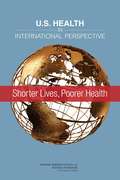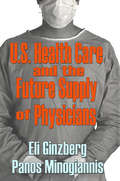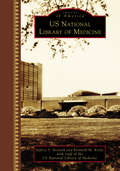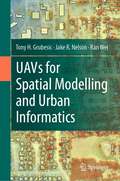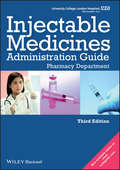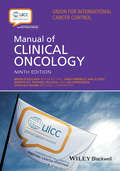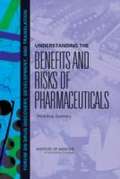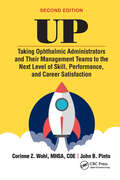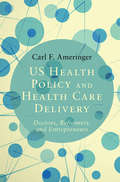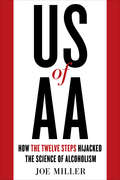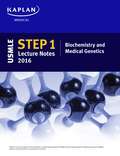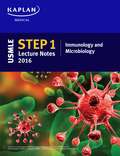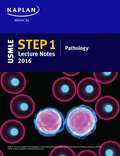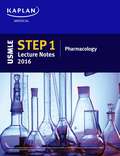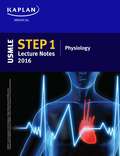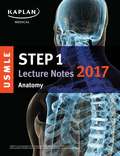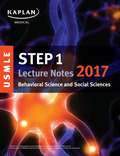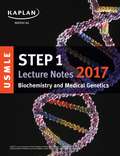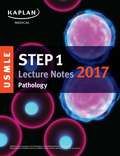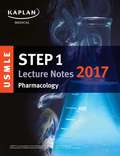- Table View
- List View
U.S. Army Ambulances & Medical Vehicles in World War II (Casemate Illustrated Special)
by Didier AndresA “cool compendium” of photos and information about the vehicles that helped save American troops’ lives (Cybermodeler).Of all the armies involved in World War II, the U.S. Army developed the most sophisticated system for the transport and treatment of injured and sick soldiers, pushing the boundaries of available technology to give their men the best chance of not only survival but a full recovery.Each infantry regiment had a medical detachment tasked with conserving the strength of the regiment by not only providing medical and dental treatment but also undertaking all possible measures to keep the regiment healthy. In combat they would provide emergency medical treatment on the battlefield, then move casualties to aid stations they had established. At aid stations, casualties would be triaged, stabilized, and treated before being moved on for further treatment. Vehicles formed a crucial part of the Medical Detachment’s equipment.This fully illustrated, comprehensive book covers all types of medical vehicles used both in-theater and in the United States, including ambulances and technical support vehicles. It details vehicle markings modifications, for use in the evacuation of troops from the battlefield, and the other uses these vehicles were adapted for during the war—including their use as “Clubmobiles” and “Chuck Wagons” by the American Red Cross.
U.S. Health in International Perspective
by Steven H. WoolfThe United States is among the wealthiest nations in the world, but it is far from the healthiest. Although life expectancy and survival rates in the United States have improved dramatically over the past century, Americans live shorter lives and experience more injuries and illnesses than people in other high-income countries. The U. S. health disadvantage cannot be attributed solely to the adverse health status of racial or ethnic minorities or poor people: even highly advantaged Americans are in worse health than their counterparts in other, "peer" countries. In light of the new and growing evidence about the U. S. health disadvantage, the National Institutes of Health asked the National Research Council (NRC) and the Institute of Medicine (IOM) to convene a panel of experts to study the issue. The Panel on Understanding Cross-National Health Differences Among High-Income Countries examined whether the U. S. health disadvantage exists across the life span, considered potential explanations, and assessed the larger implications of the findings. U. S. Health in International Perspective presents detailed evidence on the issue, explores the possible explanations for the shorter and less healthy lives of Americans than those of people in comparable countries, and recommends actions by both government and nongovernment agencies and organizations to address the U. S. health disadvantage.
U.S. Healthcare and the Future Supply of Physicians
by Eli Ginzherg Panes MinogiannisMany different sectors of modern society influence the nation's healthcare system. Government, health insurance companies, managed care organizations, academic health centers, the pharmaceutical industry, and other groups all affect healthcare. In the areas of medical access, cost, and quality, the physician remains the key to the efficiency and effectiveness of healthcare services. Eli Ginzberg and Panos Minogiannis, in Ginzberg's final book, examine the supply of health personnel in the United States. They consider the ways it has been influenced by federal and state legislation, healthcare financing, the transformation of the hospital, managed care, and health trends in the last part of the twentieth century. Through this historical approach, the book identifies key moments in U.S. health policy history that have led to problems in the geographical distribution of medical personnel, gender and race representation in the health personnel pool, and subsequent attempts to resolve these problems. This volume pays special attention to current trends in healthcare and tries to forecast the direction of the debate over health personnel supply in the coming years. Chronic care conditions and the ageing of the population on the one hand and the penetration of managed care and the subsequent transformation of American hospitals on the other converge to present policymakers with tremendous challenges in financing healthcare. Ginzberg and Minogiannis argue that a more balanced production and distribution of U.S. health personnel will go far in easing the financial burden of healthcare and at the same time improve the quality of services provided to the American people.
U.S. National Library of Medicine (Images of America)
by Jeffrey S. Reznick Kenneth M. Koyle Medicine, with staff of the US National Library ofThe US National Library of Medicine, on the campus of the National Institutes of Health in Bethesda, Maryland, has been a center of information innovation since its beginnings in the early 19th century. The world’s largest medical library and a federal government agency, it maintains and makes publicly available a diverse and world-renowned collection of materials dating from the 11th to the 21st centuries, and it produces a variety of electronic resources that millions of people around the globe search billions of times each year. The library also supports and conducts research, development, and training in biomedical informatics and health information technology, and it coordinates the National Network of Libraries of Medicine that promotes and provides access to health information in communities across the United States. As the library anticipates its third century of public service, this book offers a visual history of its development from its earliest days through the late 20th century, as the institution has involved generations of visionary leaders and dedicated individuals who experienced the American Civil War, the world wars, the Cold War, and the dawn of the information age.
UAVs for Spatial Modelling and Urban Informatics
by Tony H. Grubesic Ran Wei Jake R. NelsonThis book aims to provide a wide range of real-world applications in using unmanned aerial vehicles (UAVs) for geographic observation, spatial modeling, and urban informatics. Specifically, UAVs are incredibly effective platforms for connecting people, places, and technology. This book explores the utility of UAVs for monitoring, measuring, and improving urban infrastructure systems, urban sustainability, and the urban environment. The dynamism of cities provides opportunities for economic, social, and environmental change, but benchmarking and measuring cities continues to be challenging. This challenge is due, at least in part, to a lack of monitoring systems that can collect and analyze data at a granular enough scale to capture the nuance of local phenomena. UAVs offer a promising mechanism to fill this niche, serving as a measurement platform that can rapidly and inexpensively collect data and monitor change in cities. However, their use is fraught with social, operational, regulatory, and technical challenges for successful deployments. This book provides a resource for urbanists (e.g., planners, geographers, sociologists, epidemiologists, engineers), educators, and students who work with geographic information and seek to enhance these data using data and information from unmanned aerial vehicles. At the same time, we provide operational and methodological frameworks for carrying out these advanced analyses in a manner that considers the challenges of incorporating UAVs in research within the urban environment. We provide six unique applications of UAVs for urban analysis, detailing relevant policy and empirical questions, UAV mission parameters, data collection, spatial modeling, and the associated empirical results. Further, we discuss how best to integrate these results into actionable geospatial intelligence and policy development to improve city infrastructure systems, sustainability, the environment, and neighborhood quality.
UCL Hospitals Injectable Medicines Administration Guide: Pharmacy Department
by University College London Hospitals"I would definitely recommend this book to all staff with an interest and involvement in intravenous drug therapy." —The Pharmaceutical Journal "There is no doubt that nurses will find this small book useful. It should be available for consultation in any clinical area where drugs are administered to patients by the injectable routes." —Journal of Clinical Nursing The safe administration of injectable medicines is key to patient safety. The NPSA recognises the use of injectable medicines is a high risk activity and recommends written information about injectables to be available at the point of preparation. The UCL Hospitals Injectable Medicines Administration Guide is a practical, accessible guide covering many important aspects of administering medicines by injection. It provides clear, concise information on the preparation and administration of over 245 injectable medicines for adults, paediatrics and neonates. It is an essential resource for nurses and other healthcare professionals: it provides the key information and advice needed for the safe and effective administration of injectable medicines. The Guide’s introductory section provides a concise yet comprehensive overview of injectable therapy, including the risks and benefits of IV administration, infusion devices, and pharmaceutical aspects of injectable therapy. For each drug the alphabetically tabulated monographs provide: A practical method of preparation and administration via the IV, IM and SC routes, with risk reduction in mind at every step Expert advice from the team of specialist pharmacists at UCLH to ensure safe and pragmatic use of each medicine Monitoring advice for the management of reactions that may occur during administration Y-site and syringe driver compatibility data Minimum infusion volume data for fluid restricted patients Extravasation warnings, pH, sodium content, displacement values, stability and flush data New to this edition: 40 new monographs including recently marketed, unlicensed, rarely used and specialist medicines Detailed advice for the administration of high risk medicines such as heparin, with access to UCLH’s medicine related guidelines at www.wiley.com/go/UCLH A colour-coded NPSA risk assessment for every mode of administration for every medicine, to highlight the safest method of administration A user guide and tutorial to give new readers confidence in using and understanding the Guide Revised chapters on administration methods and devices, aseptic non-touch technique, and latex allergy Fully revised and expanded Y-site compatibility section Spiral binding to allow the book to be left open at the relevant page The Guide is also available electronically at www.uclhguide.com.
UICC Manual of Clinical Oncology
by Martin Fey Raphael E. Pollock James Brierley Brian O'Sullivan Anil D'Cruz Jan Vermorken Shao Hui HuangThe ninth edition of the UICC's Manual of Clinical Oncology supports oncology practice across the globe by providing a concise, accessible and feasible reference to state of art multidisciplinary clinical oncology. Packed with bullet points, tables, and flow charts intended to facilitate quick reference for day-to-day clinical practice in busy oncology environments Demonstrates multidisciplinary care for site specific management Takes evidence-based approaches to management, including specific treatment recommendations and investigations guided by clinical practice guidelines Provides state of art evidence-based recommendations as well as taking into consideration the lack of availability of certain medications or resources, as well as practice variations, throughout the world Includes contemporary topics on cancer treatment, such as, cancer informatics, evidence levels, principles of prognostication, survivorship, and cancer in pregnancy
UNDERSTANDING THE BENEFITS AND RISKS OF PHARMACEUTICALS: Workshop Summary
by Institute of Medicine of the National AcademiesThe National Academies Press (NAP)--publisher for the National Academies--publishes more than 200 books a year offering the most authoritative views, definitive information, and groundbreaking recommendations on a wide range of topics in science, engineering, and health. Our books are unique in that they are authored by the nation's leading experts in every scientific field.
UP: Taking Ophthalmic Administrators and Their Management Teams to the Next Level of Skill, Performance and Career Satisfaction
by John B. Pinto Corinne WohlLike having an expert mentor in your pocket, UP is a powerful, practical workbook designed to take ophthalmic administrators and practice managers to the next level of their careers, offering practical tips, concrete advice, and a step-by-step guide for any hurdle they face. Authors Corinne Wohl and John Pinto are undisputed experts in the field, having decades of experience advising ophthalmic practices of all sizes and publishing numerous books and articles on the subject. In this book, Wohl and Pinto guide administrators toward best practices in coaching and developing their entire management team. UP is also a helpful tool for physician leaders (and leaders in training), who can only accomplish their board-level goals through effective lay managers.UP provides readers with: Practical tips on how to create a customized support and development program for each manager and administrator A step-by-step process for better problem solving Worksheets, insightful self-tests, and scorecards for immediate use as part of a linear career development program
US Health Policy and Health Care Delivery: Doctors, Reformers, and Entrepreneurs
by Carl F. AmeringerThe unique composition and configuration of doctors and hospitals in the US is leading to a crisis in primary care provision. <P><P>There are significantly more specialists than generalists, and many community hospitals and outpatient facilities are concentrated in affluent areas with high rates of comprehensive insurance coverage. These particular features present difficult challenges to policymakers seeking to increase access to care. Carl F. Ameringer shows why the road to universal healthcare is not built on universal finance alone. Policymakers in other countries successfully align finance with delivery to achieve better access, lower costs, and improved population health. <P>This book explains how the US healthcare system developed, and why efforts to expand insurance coverage in the absence of significant changes to delivery could make things worse.
US of AA: How the Twelve Steps Hijacked the Science of Alcoholism
by Joe MillerIn US of AA, Miller shares the never-before-told story of how in the aftermath of prohibition America's top scientists helped launch a movement that would give rise to a multi-million-dollar treatment industry and a new government agency devoted to alcoholism that has made available millions of dollars for research. Despite the fact that this research showed that alcoholism is a complex disease requiring an array of treatment strategies, among which Alcoholics Anonymous (AA) is one of the least effective, money continued to flow to treatment facilities using approaches similar to AA. Five years in the making, his brilliant, in-depth investigative reporting into the history, politics and science of alcoholism will show how AA became our nation's de facto treatment policy, even as evidence for more effective remedies accumulated. US of AA is a character-driven, beautifully written exposé, full of secrecy, irony, liquor industry money, the shrillest of scare tactics and, at its center, a grand deception. In the tradition of Crazy by Pete Earley, and David Goldhill's Catastrophic Care, US of AA shines a much-needed spotlight on the addiction treatment industry. It will forever change the way we think about the entire enterprise.
USMLE Step 1 Lecture Notes 2016: Anatomy
by KaplanThe only official Kaplan Lecture Notes for USMLE Step 1 available for sale! Get the comprehensive information you need to ace USMLE Step 1 and match into the residency of your choice. * Up-to-date: Updated annually by Kaplan's all-star faculty * Integrated: Packed with clinical correlations and bridges between disciplines * Learner-efficient: Organized in outline format with high-yield summary boxes * Trusted: Used by thousands of students each year to succeed on USMLE Step 1
USMLE Step 1 Lecture Notes 2016: Behavioral Science and Social Sciences
by KaplanThe only official Kaplan Lecture Notes for USMLE Step 1 available for sale! Get the comprehensive information you need to ace USMLE Step 1 and match into the residency of your choice. * Up-to-date: Updated annually by Kaplan's all-star faculty * Integrated: Packed with clinical correlations and bridges between disciplines * Learner-efficient: Organized in outline format with high-yield summary boxes * Trusted: Used by thousands of students each year to succeed on USMLE Step 1
USMLE Step 1 Lecture Notes 2016: Biochemistry and Medical Genetics
by KaplanThe only official Kaplan Lecture Notes for USMLE Step 1 available for sale! Get the comprehensive information you need to ace USMLE Step 1 and match into the residency of your choice. * Up-to-date: Updated annually by Kaplan's all-star faculty * Integrated: Packed with clinical correlations and bridges between disciplines * Learner-efficient: Organized in outline format with high-yield summary boxes * Trusted: Used by thousands of students each year to succeed on USMLE Step 1
USMLE Step 1 Lecture Notes 2016: Immunology and Microbiology
by KaplanThe only official Kaplan Lecture Notes for USMLE Step 1 available for sale! Get the comprehensive information you need to ace USMLE Step 1 and match into the residency of your choice. * Up-to-date: Updated annually by Kaplan's all-star faculty * Integrated: Packed with clinical correlations and bridges between disciplines * Learner-efficient: Organized in outline format with high-yield summary boxes * Trusted: Used by thousands of students each year to succeed on USMLE Step 1
USMLE Step 1 Lecture Notes 2016: Pathology
by KaplanThe only official Kaplan Lecture Notes for USMLE Step 1 available for sale! Get the comprehensive information you need to ace USMLE Step 1 and match into the residency of your choice. * Up-to-date: Updated annually by Kaplan's all-star faculty * Integrated: Packed with clinical correlations and bridges between disciplines * Learner-efficient: Organized in outline format with high-yield summary boxes * Trusted: Used by thousands of students each year to succeed on USMLE Step 1
USMLE Step 1 Lecture Notes 2016: Pharmacology
by KaplanThe only official Kaplan Lecture Notes for USMLE Step 1 available for sale! Get the comprehensive information you need to ace USMLE Step 1 and match into the residency of your choice. * Up-to-date: Updated annually by Kaplan's all-star faculty * Integrated: Packed with clinical correlations and bridges between disciplines * Learner-efficient: Organized in outline format with high-yield summary boxes * Trusted: Used by thousands of students each year to succeed on USMLE Step 1
USMLE Step 1 Lecture Notes 2016: Physiology
by KaplanThe only official Kaplan Lecture Notes for USMLE Step 1 available for sale! Get the comprehensive information you need to ace USMLE Step 1 and match into the residency of your choice. * Up-to-date: Updated annually by Kaplan's all-star faculty * Integrated: Packed with clinical correlations and bridges between disciplines * Learner-efficient: Organized in outline format with high-yield summary boxes * Trusted: Used by thousands of students each year to succeed on USMLE Step 1
USMLE Step 1 Lecture Notes 2017: Anatomy
by Kaplan MedicalThe only official Kaplan Lecture Notes for USMLE Step 1 cover the comprehensive information you need to ace the exam and match into the residency of your choice. * Up-to-date: Updated annually by Kaplan’s all-star faculty * Integrated: Packed with clinical correlations and bridges between disciplines * Learner-efficient: Organized in outline format with high-yield summary boxes * Trusted: Used by thousands of students each year to succeed on USMLE Step 1
USMLE Step 1 Lecture Notes 2017: Behavioral Science and Social Sciences
by Kaplan MedicalThe only official Kaplan Lecture Notes for USMLE Step 1 cover the comprehensive information you need to ace the exam and match into the residency of your choice. * Up-to-date: Updated annually by Kaplan’s all-star faculty. This edition includes a section on Patient Safety Science, a topic that was recently added to the exam. * Integrated: Packed with clinical correlations and bridges between disciplines * Learner-efficient: Organized in outline format with high-yield summary boxes * Trusted: Used by thousands of students each year to succeed on USMLE Step 1
USMLE Step 1 Lecture Notes 2017: Biochemistry and Medical Genetics
by Kaplan MedicalThe only official Kaplan Lecture Notes for USMLE Step 1 cover the comprehensive information you need to ace the exam and match into the residency of your choice. * Up-to-date: Updated annually by Kaplan’s all-star faculty * Integrated: Packed with clinical correlations and bridges between disciplines * Learner-efficient: Organized in outline format with high-yield summary boxes * Trusted: Used by thousands of students each year to succeed on USMLE Step 1
USMLE Step 1 Lecture Notes 2017: Immunology and Microbiology
by Kaplan MedicalThe only official Kaplan Lecture Notes for USMLE Step 1 cover the comprehensive information you need to ace the exam and match into the residency of your choice. * Up-to-date: Updated annually by Kaplan’s all-star faculty * Integrated: Packed with clinical correlations and bridges between disciplines * Learner-efficient: Organized in outline format with high-yield summary boxes * Trusted: Used by thousands of students each year to succeed on USMLE Step 1
USMLE Step 1 Lecture Notes 2017: Pathology
by Kaplan MedicalThe only official Kaplan Lecture Notes for USMLE Step 1 cover the comprehensive information you need to ace the exam and match into the residency of your choice. * Up-to-date: Updated annually by Kaplan’s all-star faculty * Integrated: Packed with clinical correlations and bridges between disciplines * Learner-efficient: Organized in outline format with high-yield summary boxes * Trusted: Used by thousands of students each year to succeed on USMLE Step 1
USMLE Step 1 Lecture Notes 2017: Pharmacology
by Kaplan MedicalThe only official Kaplan Lecture Notes for USMLE Step 1 cover the comprehensive information you need to ace the exam and match into the residency of your choice. * Up-to-date: Updated annually by Kaplan’s all-star faculty * Integrated: Packed with clinical correlations and bridges between disciplines * Learner-efficient: Organized in outline format with high-yield summary boxes * Trusted: Used by thousands of students each year to succeed on USMLE Step 1
USMLE Step 1 Lecture Notes 2017: Physiology
by Kaplan MedicalThe only official Kaplan Lecture Notes for USMLE Step 1 cover the comprehensive information you need to ace the exam and match into the residency of your choice. * Up-to-date: Updated annually by Kaplan’s all-star faculty * Integrated: Packed with clinical correlations and bridges between disciplines * Learner-efficient: Organized in outline format with high-yield summary boxes * Trusted: Used by thousands of students each year to succeed on USMLE Step 1

